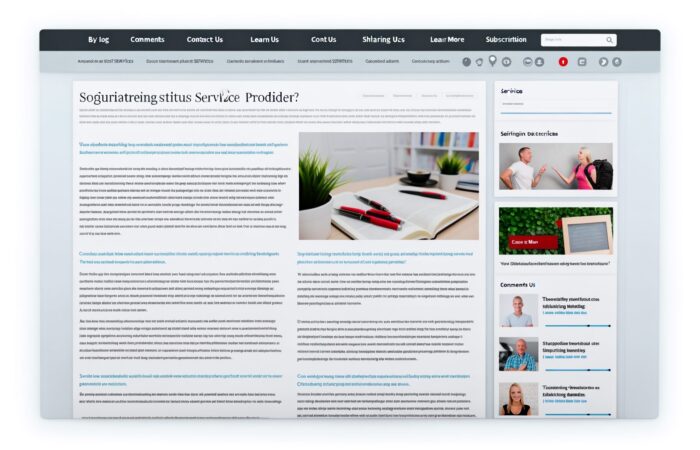So, you’re interested in learning about guest post pitches, huh? Great choice! Diving into the world of blogging and content creation can be thrilling, and getting your work featured on other sites through guest posts is an excellent way to expand your reach. Whether you’re a seasoned writer or a newbie eager to make your mark, understanding the ins and outs of crafting a killer guest post pitch is a crucial first step.
Now, you might wonder, “What exactly is a guest post pitch?” Simply put, it’s a proposal sent to editors or blog owners suggesting content that you would like to write for their websites. This isn’t just any email—it’s your chance to make a solid impression, showcase your expertise, and ultimately, secure a spot on their valuable digital real estate.
Why Bother with Guest Post Pitches?
Engaging in guest posting does more than just stroke your ego by getting your name out there. It’s a powerful tool for networking, building your brand, and yes, that all-important SEO boost through backlinks. But the foundation of all these perks lies in how effectively you pitch your guest post.
The Art and Science of Pitching
Think of your guest post pitch as a job interview for your article. You wouldn’t show up to an interview unprepared, right? Crafting your pitch requires a balance of creativity and strategy, combining the art of engaging writing with the science of marketing tactics. And just like job interviews, first impressions matter a ton. Your initial contact could be your make-or-break moment, so getting it right is non-negotiable.
Ready to Write Your Pitch?
Before you get too excited and start firing off emails, let’s put that enthusiasm to good use by boiling down what makes a guest post pitch not just good, but great:
- Relevance: Your pitch should align with the content of the blog you’re targeting. This shows respect for your potential host’s audience.
- Research: A personalized pitch indicates that you’ve spent time understanding the host blog’s style, tone, and audience.
- Value: Highlight what your guest post will offer to the host’s audience. Will it solve a problem, offer insights, or entertain?
In essence, a strong guest post pitch acts like a bridge connecting your content with new audiences, facilitating mutual benefits for both you and the host blog. It’s not just about getting a byline; it’s about sharing valuable insights where they’re most appreciated.
Alright, now that we’ve set the stage with a sprinkle of pep talk and a dash of practical advice, you’re better equipped to start your journey into the world of guest posting. Ready to take the next step? Let’s learn how to analyze and understand the target audience better, one of the key elements in ensuring the success of your guest post pitches!
Understanding the Importance of Target Audience Analysis
Now, let’s delve into one of the most crucial aspects of crafting your guest post pitch: understanding your target audience. This step is like being a detective before a big case; you need to gather all the relevant clues. After all, knowing who you are talking to is the foundation for any successful communication. Skipping this step is like winking in the dark – you know what you’re doing, but no one else does!
First things first, why is target audience analysis so important? When you understand the readership of the blog you want to guest post on, you tailor your message to resonate with that specific group. This not only increases the likelihood of your pitch being accepted but also ensures that your eventual post will engage the readers, encouraging shares and comments, and building your reputation in the niche.
Key Aspects to Analyze
So, what should you dig into? Here’s a neat breakdown:
- Demographics and Interests: Age, occupation, hobbies, and lifestyle are the basic starting points. What’s the average reader’s day like? What challenges do they face, and what solutions can you offer?
- Common Problems and Questions: What are the pain points of the audience in this sector? Looking at comments on previous posts can give you terrific insights into what readers are itching to learn and discuss.
- Preferred Content Style: Do they lean more towards casual, conversational articles, or detailed, research-based whitepapers? This will guide the tone and structure of your pitch.
Remember, a pitch is not just about suggesting a topic but showing you can present it in a way that is relevant and beneficial to the audience. A well-analyzed understanding can drastically boost your pitch’s appeal.
Tools That Can Help
Thankfully, you don’t have to be Sherlock Holmes to get this right. There are tools and techniques designed to provide deep insights into blog audiences. Here are a few to consider:
- Google Analytics and Social Media Insights: These tools offer concrete data on who’s engaging with content—think age brackets, predominant gender, location, and more.
- Surveys and Polls: Running a survey, or analyzing existing ones related to your topic, can uncover what the audience is currently interested in.
- Comments Section: This is a gold mine for understanding reader concerns and the types of individuals who engage with the content regularly.
Incorporating these tools into your research strategy will not only refine your pitch but also spark ideas for unique, reader-focused content.
In conclusion, carrying out a thorough target audience analysis not only enhances the persuasiveness of your guest post pitch but transforms how potential collaborators view your contributions. You’re not just another writer; you’re a strategic partner who truly understands their audience. With this approach, your pitches will not merely be seen—they will be considered and appreciated.
Crafting a Compelling Subject Line
Alright, let’s dive into the real game-changer: the subject line. When you’re pitching a guest post, think of your subject line as the front door to your house. It’s the first thing editors see, and you definitely want to make a good first impression! But worry not, crafting a compelling subject line is less about having a secret formula and more about sticking to the basics and understanding human curiosity.
Keep it Short and Sweet: Editors are busy folks. They scan through countless emails daily, so a succinct subject line stands a better chance of catching their eye. Aim for about 6-10 words – enough to convey your message but concise enough to retain attention. For example, “Innovative SEO Techniques for SMBs” is straightforward and tells the editor exactly what to expect.
Personalize Where Possible: Personalization does not just enhance the body of your email; it boosts your subject line too. If you can, include the editor’s name or the publication’s name. “John, Unique Perspectives on Your Recent Topic” feels a lot more engaging than a generic “Guest Post Submission”.
Spark Curiosity: Everyone loves a little intrigue! A subject line that piques curiosity can dramatically increase the chances of your email being opened. Try posing a provocative question or stating a surprising fact related to the content of your article. “Ever Wondered How Coffee Boosts SEO Productivity?” Now, who wouldn’t want to read about that?
What to Avoid in Your Subject Line
- Overused Buzzwords: Words like “synergy”, “game-changer”, or “innovative” have been so overused that they’ve almost lost their meaning in the business world. Instead, opt for clear and specific language that sets realistic expectations.
- Being Too Vague: While mystery can be beneficial, being overly cryptic can backfire. If an editor can’t tell what your email is about from the subject line, they may not open it at all.
- Caps Lock and Excessive Punctuation: THESE ARE BIG NO-NOs!!! Not only do they make your email seem unprofessional, but they can also trigger spam filters.
Remember, your subject line is your first (and sometimes only) opportunity to make an impression. It’s worth spending extra time refining it to make sure it’s as effective as possible. Think of it as the hook in your favorite song – it needs to be catchy enough to keep you engaged and wanting more.
With these tips in mind, you’re well on your way to mastering the art of the subject line. Keep honing this skill, and soon, you’ll see more of your guest post pitches getting the attention they deserve.
Structuring the Pitch: Key Components to Include
Now, let’s dive into the meat of your guest post pitch – the structure. Think of your pitch as a mini-masterpiece, artfully created to capture attention, communicate value, and compel action. Here are the essential elements you’ll want to weave into your pitch to make it irresistibly engaging.
1. Introduction: Who You Are
Start with a brief introduction of yourself. Keep it snappy and relevant. Mention your name, your expertise or role, and maybe a tidbit about what makes you passionate about the industry or topic. This isn’t just courtesy; it’s about establishing credibility. Imagine you’re at a networking event, extending a handshake and sharing a smile – that’s the vibe you want to convey.
2. Reason for Reaching Out
Next, clearly articulate why you are reaching out. Make a connection with the blog or site you’re pitching to. Perhaps you’ve been a long-time reader, or you’ve particularly enjoyed a recent article they published. A touch of personalization shows you’re not sending generic pitches to every blog on the internet.
3. Your Pitch: The Article Idea
This is the core of your pitch. Present your article idea succinctly and clearly. What’s the hook? What unique angle or fresh insight are you bringing to the table? Here, clarity and enthusiasm are your best friends. Excite your reader with the potential of your article as much as it excites you!
4. Outline & Key Points
Provide a bullet-point outline that breaks down key points of your article. This doesn’t have to be exhaustive, but enough to provide a clear picture of the content structure. This shows you’ve thought the piece through and are serious about providing value to their readers.
5. Expected Outcomes & Reader Benefits
What will their audience gain from your article? Maybe it’s practical advice, a new perspective, or solutions to common problems. Perhaps it’s an inspiring story that aligns with the kind of narratives their readers crave. Spell out the benefits, making it almost irresistible for them to decline.
6. Call To Action: The Proposal
Finish your pitch with a friendly yet assertive call to action. Propose a potential timeline, and express your readiness to discuss the article further or adjust based on their feedback. Invite dialogue—show that you’re open to collaboration and are respectful of their guidelines and editorial process.
In crafting your pitch, it’s crucial to strike a balance between professionalism and personality. Think of your email as a bridge, connecting your brilliant idea to their publication. You want this bridge to be sturdy yet inviting, structured yet adorned with personal touches that make your message stand out.
With these components, your pitch will not only read well but also tick all the boxes of what a blog editor is looking for: relevance, engagement, and professionalism. Remember, your goal is to make the editor’s job easier by presenting a finely-tuned proposal that fits seamlessly into their content strategy.
Personalization Techniques for Greater Impact
Now, let’s talk personalization. When you’re pitching a guest post, it’s easy to think that blasting a generic message across the board will save you time. But let’s face it, nothing sings ‘delete me’ louder than a one-size-fits-all email landing in the inbox. Personalizing your pitch can significantly increase your chances of catching the editor’s eye and getting that coveted ‘yes’. So, how exactly can you add that personal touch? Let’s plunge into some tried-and-tested techniques:
Doing Your Homework
First things first, research is your best friend. Start by familiarizing yourself with the content of the blog or website. What topics do they usually cover? What’s the tone of their articles? Understanding these will help you tailor your pitch to align with their content strategy, making your post a natural fit rather than a jarring outlier.
Mention Specifics
When crafting your pitch, mentioning specific details about the blog can work wonders. For instance:
- Refer to a recent article that you found insightful and explain why.
- Compliment a particular feature of the site, such as their engaging multimedia content.
This not only shows that you have genuinely engaged with their content but also that you appreciate their efforts, which can create a positive, emotional connection.
Address the Editor by Name
Nothing says personal like using someone’s name. It reflects respect and attention to detail. If the website or blog doesn’t explicitly mention the editor’s name, a quick LinkedIn search or a glance at the website’s ‘Team’ section can often lead you to the right person. A personalized greeting can set a warm tone right from the start.
Match the Tone
Is the blog’s tone professional and straightforward, or casual and witty? Matching your pitch to the blog’s tone can make your proposal feel like a seamless extension of their existing content. This doesn’t mean losing your unique voice, but it’s about striking the right balance between your style and theirs.
Highlight Mutual Benefits
While expressing how the guest post will benefit you is understandable, emphasizing how it will add value to their blog can be a game-changer. Will it bring fresh perspectives to their readers? Does it address a topic that’s trending in their industry? Make sure to outline these benefits clearly, showing that you’re thinking about their interests as well as your own.
Personal Stories or Anecdotes
If applicable, briefly sharing a personal story or anecdote related to the content you wish to write can enhance your pitch. This approach can make your proposal more memorable, relatable, and engaging.
Remember, personalization doesn’t mean overstepping boundaries or being overly familiar. It’s about respecting the recipient’s time and aligning your pitch with their needs and style. By employing these personalization techniques, you’re not just sending an email; you’re starting a conversation. And in the world of guest posting, a good conversation could be the beginning of an excellent collaboration.
Let these techniques be your guide, and tailor your approach to show that you care not just about getting your post published, but about adding genuine value to their platform.
Common Pitfalls to Avoid in Guest Posting
So, you’re ready to dive into the world of guest posting? That’s fantastic! But hold on a second. Let’s talk about some frequent missteps many enthusiastic guest bloggers make. Knowing these can save you a lot of time and help maintain your good standing with blog editors.
Failing to Follow Guidelines
First things first: always read and follow the submission guidelines. It sounds simple, right? Yet, you’d be surprised how many people skip this step! Each blog has its specific requirements — from the length of the post to the formatting details and the type of content they accept. Ignoring these instructions is one of the quickest ways to get your guest post rejected. It’s like showing up to a formal dinner in flip-flops; it just doesn’t match the occasion.
Overlooking the Blog’s Style and Tone
Each blog has its unique voice and style. Picture this: you submit a highly technical, jargon-heavy article to a blog that usually features light, conversational content. It’s going to stick out like a sore thumb! Always take time to understand the flavor of the host blog and mirror it in your post. This shows the editor that you’re not only a fan of the blog but also a thoughtful contributor who respects the audience’s preferences.
Being Overly Promotional
While guest posting is undoubtedly a great way to gain exposure, there’s a fine line between subtle promotion and blatant self-advertising. Blog editors and readers can smell overt self-promotion from a mile away, and it’s off-putting. Sure, you want to mention your brand or product, but do it in a way that adds value to the reader. Focus on being helpful, informative, or even entertaining, rather than just promotional.
Skipping the Proofreading Step
Don’t let typos or grammatical errors be the reason your post doesn’t make the cut. Always, always proofread your work before submission. Better yet, have someone else look over it. Fresh eyes can catch errors you might have missed and can also provide feedback on how your post reads. A post riddled with errors not only reflects poorly on you but also on the host blog, should it slip through the cracks.
Not Crafting Quality Content
This might seem obvious, but it’s worth emphasizing: quality is key. With the vast amount of content online, only the best content gets noticed. Invest the time to create something original, insightful, and engaging. If you’re just rehashing old ideas or cobbling together information from various sources, chances are good that you’re not adding enough value to merit publication.
Final Thoughts
Avoiding these pitfalls in guest posting isn’t just about dodging mistakes; it’s about building successful, long-term relationships with blog editors and their audiences. When you approach guest blogging with the right mindset and practices, you open doors to more opportunities and foster connections that can benefit you in numerous ways. So, take these tips to heart, refine your approach, and watch as your guest blogging efforts bloom!
Following Up on Your Guest Post Pitch
So, you’ve sent out your crafted-with-care guest post pitch. The waiting game has begun, but hold your horses—patience doesn’t mean idleness! Following up is a delicate art that can significantly boost your chances of success, if done right. Let’s get into the nuts and bolts of effectively following up without treading into the land of nuisance.
Timing is Everything
When you follow up can be as crucial as how you do it. Generally, giving the editor about one to two weeks to respond to your original pitch is a good rule of thumb. It strikes the balance between giving them enough time to consider your pitch amidst their undoubtedly busy schedule, and not letting your pitch get lost in the sands of time.
The Polite Nudge
When the time does come to follow up, keep your message short, sweet, and to the point. Start by gently reminding them of your initial email (they get tons, remember?), and express your continued interest in contributing to their platform. Make sure to convey your message with enthusiasm, yet without desperation. Something like, “Hi [Editor’s Name], I wanted to touch base regarding the pitch I sent last week about [Your Topic]. I’m really excited about the possibility of sharing this with your audience and would love to know your thoughts!”
Brevity is the Soul of Wit
Yes, Shakespeare’s advice holds true even here. Your follow-up email isn’t the place to re-pitch your idea or add new suggestions. Keep it concise. Reiterate your main point, perhaps link back to your original email, and leave it there. The goal is to jog their memory, not overwhelm it.
Plan B: The Gentle Closure
If you’ve followed up a couple of times and still haven’t received a response, it might be time to send a closure email. This is your chance to be professional and gracious, letting them know you’re withdrawing your pitch so you can pitch it elsewhere, but would still love the opportunity to collaborate in the future. An example could be, “Hello [Editor’s Name], I understand you have a lot on your plate, and haven’t been able to consider my pitch on [Your Topic]. I’ll look at other avenues for this piece but would love to keep the door open for future submissions. Thanks a million for your time!” This sort of email keeps the relationship positive and keeps you in their good books for future pitches.
Keep the Door Open
Whether your follow-up results in a green light to write, or a need to move on, always end on a positive note. Building relationships is key in the world of guest posting, and today’s ‘no’ can easily be tomorrow’s ‘yes’. Stay professional, optimistic, and open to future communications.
Remember, following up is more than just an administrative task—it’s an opportunity to show your professionalism and passion. Done rightly, it can make all the difference to your guest posting efforts. So, take a deep breath, follow these tips, and watch your guest blogging world expand!











No Comment! Be the first one.